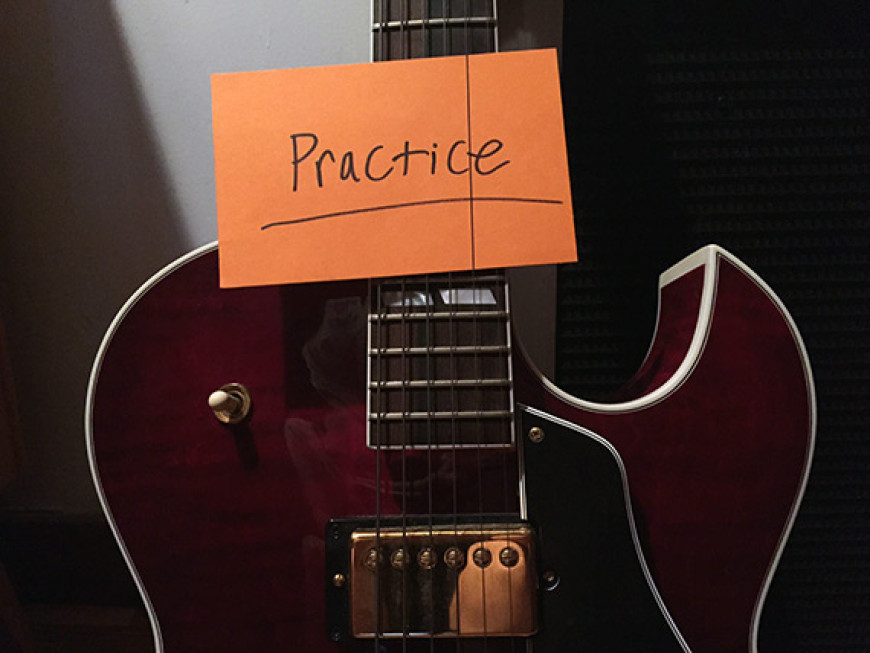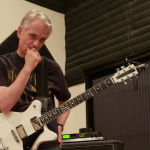How to Practice

Everyone needs to practice to become proficient on their instrument. I personally have spent countless hours (and still do) doing exactly that—all in pursuit of a deeper rapport with the guitar. Ambitions vary greatly, as does the amount of time needed to achieve the goals that are aspired to. It’s an ongoing process which never really ends as long as the musician retains the desire to evolve.
I’d like to address the issue of how to practice, or maybe we should say “how to make use of limited practice time”. It seems like unless you’re a child prodigy tucked away in a conservatory somewhere, you never seem to have quite enough time to get it together the way you feel you should. School, work, social and business obligations, commuting from one thing to the other—it’s like a conspiracy to rob you of your time and energy! I’m joking, but you know what I mean. It takes a concerted effort to make it happen, musically speaking. You have to prioritize and set up some realistic guidelines.
First off, you might want to figure out how much time you realistically have in any given day to devote to uninterrupted practice. 45 minutes? 2 hours? More? Try to find a figure that allows you to become totally involved—mentally and physically—with no distractions! In other words, clear a space in your room (or studio, or car, wherever) and in your mind. Prepare yourself for being in complete focus with your music for a solid block of time.
I usually start with warmups of some kind. I have dozens of exercises which I’ve either invented or adapted from others over the years. I’ve shared these with my students and I think they do what they’re supposed to do—get the hands moving, get your eyes “seeing the shapes” (though not relying on the visuals entirely) and “opening the ears” so that you’re mentally “singing along” as you play. Scales, arpeggios, dedicated right and left hand exercises, etc—everyone should have their own collection which they can call upon as needed. If you read music in standard notation, there’s works by authors such as Nicolas Slonimsky and Yusef Lateef that contain loads of useful material, as well as the more guitar related books by Howard Roberts, Mickey Baker, Gustavo Assis-Brasil, and others. Some of these have been transcribed into guitar tablature for easier reading. Spend some time and find material which suits your own taste and sensibility and then memorize it, transpose it, play it backwards, etc until you’ve worn it out!
Taking this approach further, I usually try to work on striking a balance between practicing things which require memorization and a more precise approach and things which require improvising and a less structured feel. I think the mental exercise of memorizing new material is crucial to development—whether its phrases and fragments of solos by other guitarists or full length compositions. Anything which forces you to concentrate and play a structured succession of melodic and harmonic material (while keeping a steady tempo and staying in time) will make your playing more precise and improve your technique. In addition to the composers and guitarists I’ve mentioned earlier, I’ve had good luck over the years adapting sections of classical guitar pieces by modern composers such as Leo Brouwer, Hans Werner Henze, Toru Takemitsu, Guido Santorsola, etc and playing them on electric guitar. There’s also the older composers such as Bach, who adapts quite nicely on the guitar. Not only do I get the benefits of improving my technique, I also enjoy having new ideas “under my fingers” which I can then draw inspiration from for my own compositions. Keeping fresh input coming in means that I will (hopefully) process and internalize this into fresh output.
Now let’s take the time (or make time) to improvise. If playing from memory is pulling things from the past, then perhaps improvising can be “playing in the now” or spontaneously creating in the present. For most musicians, especially guitarists, improvising means playing an unrehearsed series of melodic phrases over a musical background provided by a rhythm section. In other words, “jamming on some changes”—whether in a jazzy style, with a country feel, in a rock format, etc. There are many excellent play-along book/cd/ downloads available for practicing this angle if a live rhythm section is unavailable (or unwilling!) so by all means make it a part of your regular practice schedule. Start out by learning the chord progressions and just play rhythm guitar at first. Once you feel solid with this, start playing melodic patterns over the given chord sequences. Most of us have a collection of personal licks and fragments that we recycle in various permutations, occasionally interspersed with odd bits of new ideas that show up now and then. A certain amount of repetition is natural—that’s how a definable style happens. It’s also natural to change over time and evolve without consciously disregarding one’s past. The important thing is to just do it and enjoy the buzz that comes from having your mind and body working together to create something that’s physically and mentally challenging. As you become more facile and fluent, you’ll start creating music which can then be enjoyed not just as an exercise but as an enjoyable listening experience for others as well.
So that’s it. If you can make time to run through your memorized and structured music and your unstructured improvised music, you should be in good shape to develop your musical abilities and (hopefully) adapt to whatever playing situation you find yourself in. That’s our goal.
For further reading:
The Art of Practicing by Madeline Bruser
The Advancing Guitarist by Mick Goodrick
The Inner Game of Tennis by W. Timothy Gallwey
Learn Guitar
 Duane Denison is a renowned guitarist and educator. Named one of the top 100 guitarists of all time by Spin Magazine.
Duane Denison is a renowned guitarist and educator. Named one of the top 100 guitarists of all time by Spin Magazine.
Want to send him a message? View Duane's teaching profile page>>
